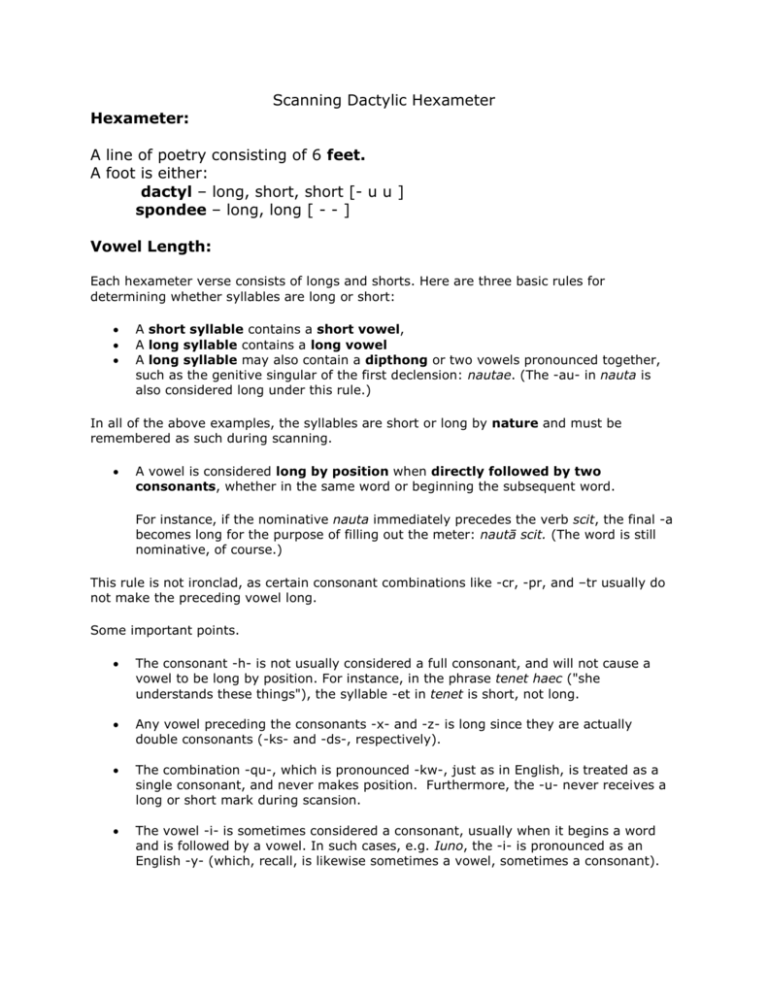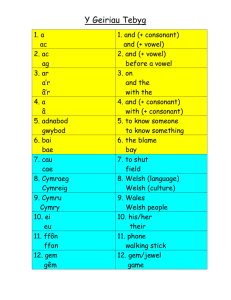Scanning Dactylic Hexameter
advertisement

Scanning Dactylic Hexameter
Hexameter:
A line of poetry consisting of 6 feet.
A foot is either:
dactyl – long, short, short [- u u ]
spondee – long, long [ - - ]
Vowel Length:
Each hexameter verse consists of longs and shorts. Here are three basic rules for
determining whether syllables are long or short:
A short syllable contains a short vowel,
A long syllable contains a long vowel
A long syllable may also contain a dipthong or two vowels pronounced together,
such as the genitive singular of the first declension: nautae. (The -au- in nauta is
also considered long under this rule.)
In all of the above examples, the syllables are short or long by nature and must be
remembered as such during scanning.
A vowel is considered long by position when directly followed by two
consonants, whether in the same word or beginning the subsequent word.
For instance, if the nominative nauta immediately precedes the verb scit, the final -a
becomes long for the purpose of filling out the meter: nautā scit. (The word is still
nominative, of course.)
This rule is not ironclad, as certain consonant combinations like -cr, -pr, and –tr usually do
not make the preceding vowel long.
Some important points.
The consonant -h- is not usually considered a full consonant, and will not cause a
vowel to be long by position. For instance, in the phrase tenet haec ("she
understands these things"), the syllable -et in tenet is short, not long.
Any vowel preceding the consonants -x- and -z- is long since they are actually
double consonants (-ks- and -ds-, respectively).
The combination -qu-, which is pronounced -kw-, just as in English, is treated as a
single consonant, and never makes position. Furthermore, the -u- never receives a
long or short mark during scansion.
The vowel -i- is sometimes considered a consonant, usually when it begins a word
and is followed by a vowel. In such cases, e.g. Iuno, the -i- is pronounced as an
English -y- (which, recall, is likewise sometimes a vowel, sometimes a consonant).
Syllabification:
Syllables are usually divided between a vowel and a single consonant: vi-rum,
not vir-um.
When a vowel is followed by two consonants in the same word, the division comes
between the consonants: ar-ma, not arm-a or a-rma.
Note: The combination -qu-, which is treated like a single consonant
Elision:
A final syllable ending in a vowel elides with a word beginning with a vowel (or an h-).
A final syllable ending in the letter -m elides with a word beginning with a vowel (or an h-).
Note: On occasion, the elision, for metrical reasons, does not take place. The term for deliberate
avoidance of elision is called hiatus(> Lat. "gap").
Diaeresis
You may have observed that in dividing up a verse into feet, the divisions must often be
made within the words themselves, so that the boundaries between feet rarely correspond
to the boundaries between words. When the end of a foot also coincides with the end of a
word, the resulting division is called a diaeresis.
Opening of the Aeneid
Arma virumque cano Troiae qui primus ab oris
{note: a Latin word usually has as many syllables as vowels, but the word
“Troiae” contains 2 dipthongs}
Italiam fato profugus Laviniaque venit
{note: the word “Laviniaque” contains an example of synezesis = a forced
dipthong}
litora multum ille et terris iactatus et alto
{note: “m” sandwich and the elision of “ille et” and “iactatus” is a
consonantal “I” = jactatus}
vi superum saevae memorem Iunonis ob iram
{note: “Iunonis” is a consonantal “I” = Junonis and “saevae” contains two –
ae dipthongs}
multa quoque et bello passus dum conderet urbem
inferretque deos Latio genus unde Latinum
Albanique patres atque altae moenia Romae.
{note: “moenia” is synezesis = moYnia; “Romae” has the –ae dipthong}







